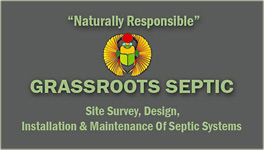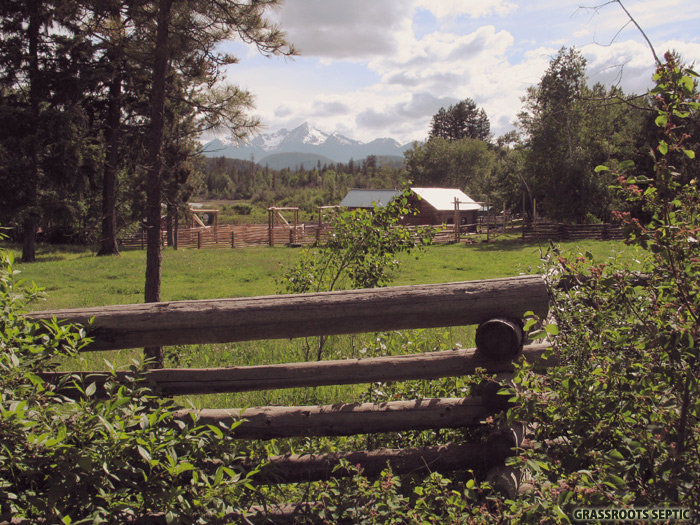 |
|
Grassroots Septic recently designed and installed my Septic System. They carried out everything extremely professionally, on time and cost effectively. I was also able to assist in the installation which helped me reduce the cost. I was completely satisfied with the high quality of my system design and installation. - Frank.
On May 31, 2005 British Columbia (B.C.) regulations governing onsite wastewater sewerage disposal became the Sewerage System Regulation (SSR). The SSR represents a significant shift from the former Health Authority process to an industry-reliant filing system. Since that date there have been a number of modifications to the act. Significantly, in June 2010 the SSR was modified to allow home owners to install their onsite system. However it must be noted that the installation is conducted under the supervision of a professional Registered Onsite Wastewater Practitioner (ROWP). A ROWP must oversee and take responsibility for a homeowner installation on private property. A homeowner installation must follow all aspects of the Act, i.e. it must be designed in accordance with the SSR, a proper filing must be made, installation must be per the SSR and all documentation must be signed off by the ROWP.
What is a wastewater onsite system?This is the official terminology for what is commonly called a "septic system". British Columbia (B.C.) Provincial regulations define it as "a system for treating domestic sewage that uses one or more treatment methods and a discharge area, but does not include a holding tank or privy". The term "wastewater" is often used interchangeably with "sewage".
Most B.C. homes outside major urban areas do not have access to a public sanitary sewer system – a city sewer hook-up, in other words. That means it is up to the home owner to treat and disperse wastewater on her or his property in accordance with Provincial Regulations.
These systems are designed to match the expected usage of the building occupants, the size and type of the planned or existing building, along with the limitations of the property and soil type. The goal is to treat and disperse wastewater in a manner that poses no risk to health or the environment.
A system may include either a septic tank for a physical separation of solids from liquids, or treatment plant or process for physical as well as biological treatment. From the septic tank or treatment plant/process, the effluent is directed to a dispersal area which could be one of many styles including standard trenches, a sand mound or even drip irrigation. The physical and biological characteristics of the soil continue the treatment process and break down or use the nutrients and otherwise harmful components of the wastewater. When functioning as designed and maintained properly, a system will return water into the environment that is safe.Many older styles of systems used a simple gravity-based means to transport fluids from the home to the final soil treatment area. Today many systems require a pump set into a separate chamber with a control panel and alarms for monitoring its operation. These more advanced methods can improve the life span of the system, often substantially, but with these components comes an added cost over the older, simpler styles.
Keeping it simple is always the preferred choice but, as properties become smaller and groundwater a concern, more advanced systems may become a requirement rather than an option.
Improved SystemsBecause systems must now be designed to match site conditions and use, the regulations encourages the design and installation of quality on-site systems.
As the new approach encourages higher quality to ensure long life-spans, and as private contractors are taking responsibility previously taken by government, some systems are now more expensive than in the past. In other cases, the increased flexibility under the SSR leads to reduced costs. A quality on-site system is now seen as a real estate asset.
On-site Sewage Systems - Septic System
Onsite sewage systems are effective at treating household sewage if designed and installed properly in appropriate soil and maintained regularly. In typical onsite sewage systems, the wastewater from toilets and other drains flows from your house into a tank that separates the solids and scum from the liquid. Bacteria help break down the solids into sludge. The liquid flows out of the tank into a network of pipes buried in a disposal field of gravel and soil. Holes in the pipes allow the wastewater to be released into the disposal field. The soil, gravel and naturally occurring bacteria in the soil filter and cleanse the wastewater. There are about 250,000 on-site sewage systems in British Columbia, despite expansion of municipal sewage collection and treatment facilities.
On-site systems that are poorly planned, constructed or maintained present substantial threats to water quality. Onsite sewage systems can fail and untreated wastewater can be carried to nearby water bodies threatening human health, causing excessive algal growth and harming aquatic life. If your on-site system is not properly located on your property or does not have an appropriate depth of suitable soil, the system may not fully treat the wastewater. The wastewater can seep down into the ground water polluting drinking water supplies or rise to the surface and flow over land into nearby water bodies. If you don’t have adequate treatment in your septic tank, the solids and scum can flow into the drain field and plug it up. If the drain field gets clogged, untreated wastewater can rise to the surface threatening your family’s and neighbours’ health, reducing the value of your property and creating odours and the need for costly repairs.
The regulation describes three different types of systems:
Type 1 System
Treatment by septic tank only (very minimal treatment due to the inefficient nature of the microorganisms that can live in a septic tank).
Type 2 System
Treatment by package treatment plant or treatment process. Wastewater (called effluent) leaving the treatment plant/process can be expected to have treated the waste to a particular level, which is defined as "less than 45mg/litre of total suspended solids and less than 45mg/litre of biological oxygen demand".
Type 3 System
Treatment by specialized package treatment plant or treatment process. Wastewater (called effluent) leaving the treatment plant/process can be expected to have treated the waste to a particular level, which is defined as "less than 10mg/litre of total suspended solids, less than 10mg/litre of biological oxygen demand and a median fecal coliform (fecal bacteria) density of less than 400 colony-forming units per 100ml". Simply put, Type 3 is the most complex style of on-site system, the most effective treatment and is used where there are concerns about how highly treated the wastewater needs to be before it enters the environment. A Type 1 system is the least complex and is used when there is less concern about how well treated the wastewater is before it enters the environment.
The type of system designed is also divided into system functionality:
Gravity - a system that uses gravity to flow effluent from the septic tank to the drain field
Pressure - a system that uses pressure (commonly through the use of an effluent pump) to push effluent from a pump chamber to the drain field
Gravity or pressure design can be used in Type 1, 2 or 3 systems.
A common mistake is to think of a pressure design as the "type" of system. As demonstrated above, the "type" of system is defined by the strength of effluent reaching the drain field Gravity or pressure is simply the delivery process.
The use of a simple Type 1 gravity system (the least treatment) can be problematic in certain soil conditions and topographic areas. A Type 1 pressure system is now becoming the most widely used system in standard applications. The most significant advantage that a pressure design has over the gravity design is the ability to site the drain field in restrictive topographic situations.

| HOME PAGE • SERVICES • RESOURCES • YOUR SYSTEM |
GRASSROOTS SEPTIC
T. 250.397.2250 • C. 250.644.8763 • E. peter@grassrootsseptic.com
Box 22, Eagle Creek BC, V0K 1L0